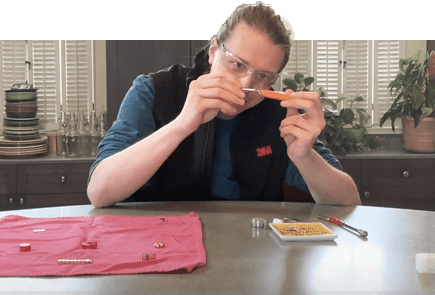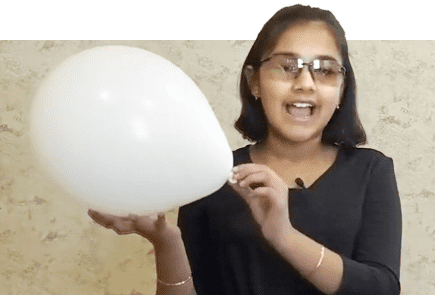Ever wonder why things mix (or don’t mix) differently in different temperatures of water? Join Camille Schrier, a scientist who was crowned Miss America 2020, as she explains how substances move through water.
Background
Diffusion is the mixing of substances due to the movement of their particles. This can occur with all sorts of matter, but is most commonly observed in liquids and gases. Typically, diffusion refers to the movement of molecules from high concentrations to lower concentrations. The rate of this movement depends on the energy of the molecules. Think of how delicious smells from your kitchen take longer to get into your bedroom than to your living room which is located right beside the kitchen. That is because the molecules from the food odor haven't diffused into that space yet. In this experiment, you will experience how temperature affects the mixing of food coloring drops with water.
Key Concepts
- Diffusion
- Temperature and Molecules
Materials
- An adult helper
- Two clear glasses
- Water
- Food coloring
Preparation
- Fill one glass half full of the coldest water you can get from the tap
- Fill the other glass the same amount with the hottest water you can get from the tap
- Make a prediction. What might be different about the way the food coloring moves through the cold water and the hot water?
- At the exact same time, add 2-3 drops off food coloring into each glass. Do not mix or stir.
- Watch what happens to the food coloring. Does it move differently in the hot water than the cold water?
- Be sure to clean up when you are done. Wipe up any spills that may have happened. Pour all of the water down the sink, and wash out the glasses. Put the food coloring back where you found it.
Observation and Results
The food coloring mixes through the hot water faster than it mixes with the cold water. This is because in hot water, the water molecules have more energy and are moving faster than the molecules of cold water. This makes it easier for the dye to get mixed throughout the hot water. Because diffusion happens from high concentration to low concentration, the more molecules are moving, the more opportunities they have to mix together. The high energy hot water model diffusion is important because it’s how we get oxygen to all the cells in our bodies. When deoxygenated blood is in your capillaries in your lungs, the oxygen in your lungs diffuses from a higher concentration in your lungs to the lower concentration in your blood. This allows red blood cells to carry oxygen all over your body.
In this experiment, the food coloring that gets added is the same temperature in each of the hot and cold water tests. Do you think the temperature of the food coloring might have an effect on how it diffuses? Can you find a safe way to heat or cool the food coloring before adding it to the water? Can you predict, based on the first way of doing the experiment, what might change, if anything?
Also, think about where you see this happen in other places. For example, how might this play into why coffee and tea always start with hot water? If you find an example of where hot or cold water is used for something that might involve diffusion, see if you can try it with the opposite and observe any differences in the results.
Safety First and Adult Supervision
- Follow the experiment’s instructions carefully.
- A responsible adult should assist with each experiment.
- While science experiments at home are exciting ways to learn about science hands-on, please note that some may require participants to take extra safety precautions and/or make a mess.
- Adults should handle or assist with potentially harmful materials or sharp objects.
- Adult should review each experiment and determine what the appropriate age is for the student’s participation in each activity before conducting any experiment.
Next Generation Science Standard (NGSS) Supported - Disciplinary Core Ideas
This experiment was selected for Science at Home because it teaches NGSS Disciplinary Core Ideas, which have broad importance within or across multiple science or engineering disciplines.
Learn more about how this experiment is based in NGSS Disciplinary Core Ideas.
Engineering Design (ETS)1: Engineering Design
Grades K-2
- 2-PS1-1. Different kinds of matter exist and can be described by its observable properties.
- 2-PS1-2. Different properties are suited to different purposes.
Grades 3-5
- 5-PS1-1. Matter of any type can be subdivided into particles that are too small to see, but event then the matter still exists and can be detected by other means.
Grades 6-8
- MS-PS1-1. Atoms form molecules that range in size from two to thousands of atoms. Molecules may be extended structures with repeating subunits.
- MS-PS1-2. Each pure substance has characteristic physical and chemical properties that can be used to identify it.
- MS-PS1-4. In a solid, atoms are closely spaced and may vibrate in position but do not change relative locations.
Grades 9-12
- HS-PS1-1. Each atom has a charged substructure consisting of a nucleus, which is made of protons and neutrons, surrounded by electrons.
- HS-PS1-2. The periodic table orders elements horizontally by the number of protons in the atom's nucleus and places those with similar chemical properties in columns. The repeating patterns of this table reflect pattern of outer electron states.
- HS-PS1-3. The structure and interactions of matter at the bulk scale are determined by electrical forces within and between atoms.
- HS-PS1-4. Stable forms of matter are those in which the electric and magnetic field energy is minimized.
Grades K-2
- K-PS2-1. Pushes and pulls can have different strengths and directions.
- K-PS2-2. Pushing or pulling on an object can change the speed or direction of its motion and can start or stop it.
Grades 3-5
- 3-PS2-1. Each force acts on one particular object and has both strength and a direction. An object at rest typically has multiple forces acting on it, but they add to give zero net force on the object. Forces that do not sum to zero can cause changes in the object’s speed or direction of motion.
- 3-PS2-2. The patterns of an object's motion in various situations can be observed and measured; when that past motion exhibits a regular pattern, future motion can be predicted from it.
Grades 6-8
- MS-PS2-1. For any pair of interacting objects, the force exerted by the first object on the second object is equal in strength to the force that the second object exerts on the first, but in the opposite direction.
- MS-PS2-2. The motion of an object is determined by the sum of the forces acting on it; if the total force on the object is not zero its motion will change. The greater the mass of the object, the greater the force needed to achieve the same change in motion. For any given object, a larger force causes a larger change in motion.
Grades 9-12
- HS-PS2-1. Newton’s second law accurately predicts changes in the motion of macroscopic objects.
- HS-PS2-2. Momentum is defined for a particular frame of reference; it is the ass times the velocity of the object. In any system, total momentum is always conserved.
- HS-PS1-3. If a system interacts with objects outside itself, the total momentum of the system can change; however, any such change is balanced by changes in the moment of objects outside the system.
Grades K-2
- K-PS2-1. When objects touch or collide, they push on one another and can change motion.
Grades 3-5
- 3-PS2-1. Objects in contact exert forces on each other.
- 3-PS2-3. Electric and magnetic forces between a pair of objects do not require the objects to be in contact.
- 3-PS2-4. The sizes of the forces in each situation depend on the properties of the objects and their distance apart and, for forces between two magnets, on their orientation relative to each other.
Grades 6-8
- MS-PS2-3. Electric and magnetic forces can be attractive or repulsive, and their sizes depend on the magnitudes of the charges, currents, or magnetic strengths involved and on the distance between the interacting objects.
- MS-PS2-5. Forces that act at a distance can be explained by fields that extend through space and can be mapped by their effect on a test object.
Grades 9-12
- HS-PS2-4. Forces at a distance are explained by fields permeating space than can transfer energy through space.
- HS-PS2-5. Magnets or electric currents cause magnetic field; electric charges or changing magnetic fields cause electric fields.
- HS-PS2-6. Attraction and repulsion between electric charges at the atomic scale explain the structure, properties, and the constant forces between material objects.
Grades K-2
- K-PS2-1. A bigger push or pull makes things go faster.
Grades 3-5
- 4-PS3-3. When objects collide, the contact forces transfer energy so as to change the objects' motions.
Grades 6-8
- MS-PS3-2. When two objects interact, each one exerts a force on the other that can cause energy to be transferred to or from the object.
Grades 9-12
- HS-PS3-5. When two objects interacting through a field change relative position, the energy stored in the field is changes.
Explore Additional Science at Home Videos and Activities

Push and Pull
Follow along with 3M’s Sam Reiss, as he shows you that magnetism is more than just a simple push and pull – it’s an example of the power of the earth itself.

Feeling Sound
Believe it or not, you can feel sound! Join Gitanjali Rao, former Discovery Education 3M Young Scientist Challenge winner, as she teaches about the frequency of sound and how we perceive pitch.

Inflation Station
Follow along with 3M’s Chief Science Advocate, Jayshree Seth, as she teaches students how chemistry can help put some air where it’s most needed!

